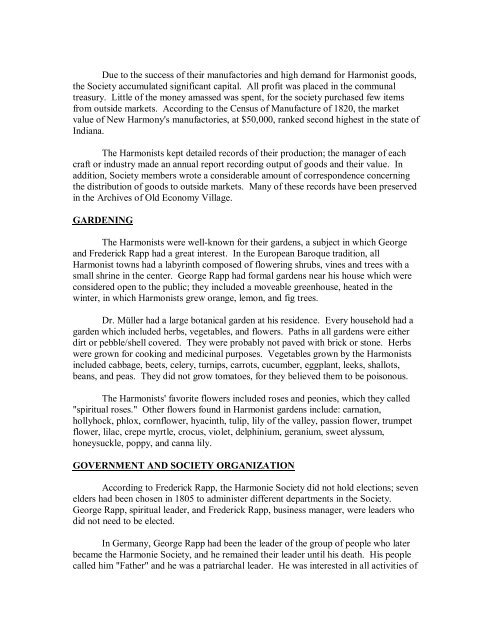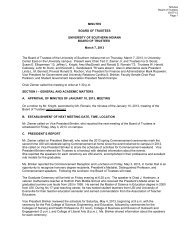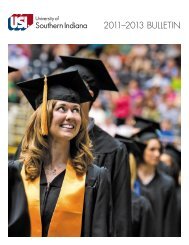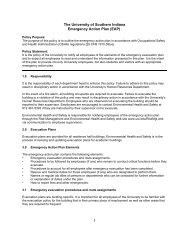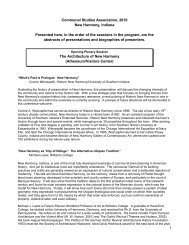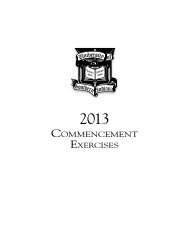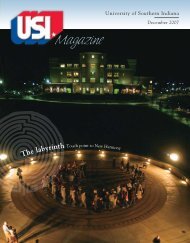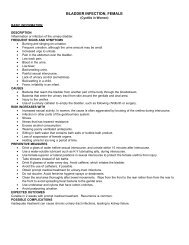The Harmonie Society - University of Southern Indiana
The Harmonie Society - University of Southern Indiana
The Harmonie Society - University of Southern Indiana
Create successful ePaper yourself
Turn your PDF publications into a flip-book with our unique Google optimized e-Paper software.
Due to the success <strong>of</strong> their manufactories and high demand for Harmonist goods,<br />
the <strong>Society</strong> accumulated significant capital. All pr<strong>of</strong>it was placed in the communal<br />
treasury. Little <strong>of</strong> the money amassed was spent, for the society purchased few items<br />
from outside markets. According to the Census <strong>of</strong> Manufacture <strong>of</strong> 1820, the market<br />
value <strong>of</strong> New Harmony's manufactories, at $50,000, ranked second highest in the state <strong>of</strong><br />
<strong>Indiana</strong>.<br />
<strong>The</strong> Harmonists kept detailed records <strong>of</strong> their production; the manager <strong>of</strong> each<br />
craft or industry made an annual report recording output <strong>of</strong> goods and their value. In<br />
addition, <strong>Society</strong> members wrote a considerable amount <strong>of</strong> correspondence concerning<br />
the distribution <strong>of</strong> goods to outside markets. Many <strong>of</strong> these records have been preserved<br />
in the Archives <strong>of</strong> Old Economy Village.<br />
GARDENING<br />
<strong>The</strong> Harmonists were wellknown for their gardens, a subject in which George<br />
and Frederick Rapp had a great interest. In the European Baroque tradition, all<br />
Harmonist towns had a labyrinth composed <strong>of</strong> flowering shrubs, vines and trees with a<br />
small shrine in the center. George Rapp had formal gardens near his house which were<br />
considered open to the public; they included a moveable greenhouse, heated in the<br />
winter, in which Harmonists grew orange, lemon, and fig trees.<br />
Dr. Müller had a large botanical garden at his residence. Every household had a<br />
garden which included herbs, vegetables, and flowers. Paths in all gardens were either<br />
dirt or pebble/shell covered. <strong>The</strong>y were probably not paved with brick or stone. Herbs<br />
were grown for cooking and medicinal purposes. Vegetables grown by the Harmonists<br />
included cabbage, beets, celery, turnips, carrots, cucumber, eggplant, leeks, shallots,<br />
beans, and peas. <strong>The</strong>y did not grow tomatoes, for they believed them to be poisonous.<br />
<strong>The</strong> Harmonists' favorite flowers included roses and peonies, which they called<br />
"spiritual roses." Other flowers found in Harmonist gardens include: carnation,<br />
hollyhock, phlox, cornflower, hyacinth, tulip, lily <strong>of</strong> the valley, passion flower, trumpet<br />
flower, lilac, crepe myrtle, crocus, violet, delphinium, geranium, sweet alyssum,<br />
honeysuckle, poppy, and canna lily.<br />
GOVERNMENT AND SOCIETY ORGANIZATION<br />
According to Frederick Rapp, the <strong>Harmonie</strong> <strong>Society</strong> did not hold elections; seven<br />
elders had been chosen in 1805 to administer different departments in the <strong>Society</strong>.<br />
George Rapp, spiritual leader, and Frederick Rapp, business manager, were leaders who<br />
did not need to be elected.<br />
In Germany, George Rapp had been the leader <strong>of</strong> the group <strong>of</strong> people who later<br />
became the <strong>Harmonie</strong> <strong>Society</strong>, and he remained their leader until his death. His people<br />
called him "Father" and he was a patriarchal leader. He was interested in all activities <strong>of</strong>


